Perry, Perry On The Wall … Who’s the Biggest Brother Of All?

For reasons not quite clear, Perry Anderson does a hatchet job on India, using selective data on police, prisons, surveillance. Better data leads to conclusions different from Perry Anderson’s.
|
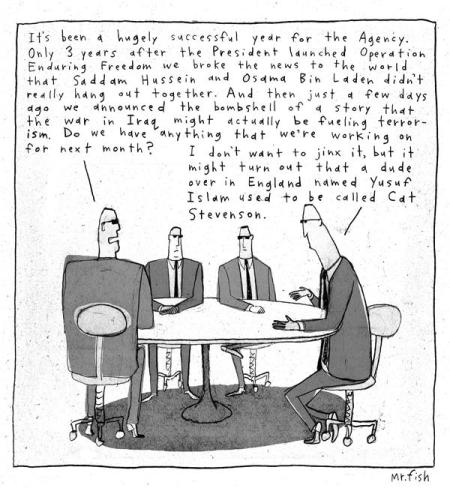
After millions of agents and billions of dollaqrs … | Cartoon By Dwayne Booth, Mr. Fish – 9/25/2006 12:00:00 AM; source & courtesy – cagle.com
Changing spots
Employed with an American university (UCLA) for 30-years, Perry Anderson, a Marxist professor of British origin, has been completely taken up with India.
Published in July was his first-post, Gandhi Centre Stage (LRB 5 July 2012), and his next post was After Nehru (LRB 2 August 2012). Between these two posts, Perry Anderson has come up with some 33,000 words.
Enough material for a 100-page book.
Follow the money
Cleverly mixed with his reluctant admissions of truths, half-untruths, and complete lies, it is unclear why he has taken up such a project.
Why India?
As a Marxist, wouldn’t Communist China or Socialist Russia be an easier – and more interesting objects for Perry Anderson’s affections? For me, Socialist Germany is the most interesting country-study one can do today.
As a Marxist, it is again rather puzzling that Perry Anderson has so much thinly-veiled pride for colonial-imperial Britain – and such antipathy towards an earnest, wannabe-socialist India.
This is the third of the posts for a 2ndlook at some issues that Perry Anderson raises in his posts.

Perry, Perry on the wall? Should he West not be worried miore about itself? | Justice Is Suspicious Character in Sanford Florida; By RJ Matson, The St. Louis Post Dispatch – 4/17/2012 12:00:00 AM
Big Brother
Perry Anderson makes an interesting point on India.
the role and character of the army, the Central Reserve Police Force, Border Security Force, Central Industrial Security Force, Home Guards, let alone the clandestine powers and activities of the Intelligence Bureau (a vast military, paramilitary and surveillance complex, totalling upwards of two million operatives), receive even passing mention in most of the literature on the world’s largest democracy.
Perry Anderson does not provide any comparative aggregates, for any other country. Either at a gross level or on a per-capita basis.
Except India.
Perry Anderson expects us to accept his surmise at face-value – without further examination, data or evidence? By not providing comparative data Perry Anderson attempts to imply that the numbers he provides for India is a large number – and other comparable countries are lower.
Which is completely untrue!
But, not to worry!
Cross country statistics are hard to come by. Takes some searching, but on some country pairs, some data is available.
For instance, India and USA.
Increasing data on this subject have been available to 2ndlook readers for the last 5 years.
Does Perry Anderson’s India numbers include army, police, para-military, industrial security forces?
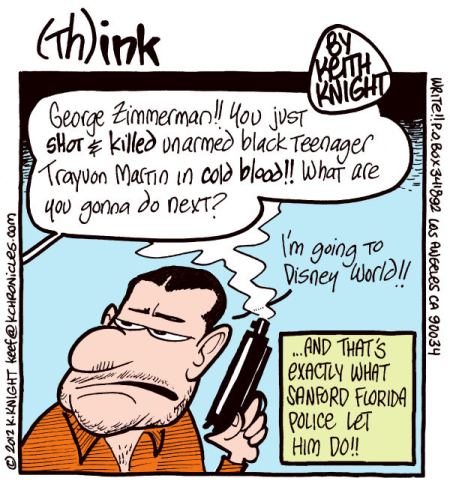
150 years after Emancipation; 50 years after civil rights movement, we are left with this | Disney World By Keith Knight, PoliticalCartoons.com – 3/27/2012 12:00:00 AM
Half Untruths
Let us check out some data to see how valid Perry Anderson’s claim is about India’s ‘vast military, paramilitary and surveillance complex, totalling upwards of two million operatives’.
Before going further let us look at some data on Indian police & military size.
- CRPF – 3 lakhs
- BSF – 2.5 lakhs
- Railway Protection Force – 0.65 lakh
- CISF – 0.25 lakh
- Civilian Police – 10 lakhs
- Total Police – 16 lakhs (total of 1-5 items).
- Indian Armed Forces – 13.25 lakhs
- State Total – 30 lakhs
- Private Security Total – 30 lakhs
I wonder from where does Perry pull out the 2-million figure – when the actual is closer to 3 million?
Let us look at USA – the only Western country close to India in terms of size, diversity, population.
US Police & Military
- US Armed Forces – 15 lakhs
- US Civilian Police – 10 lakhs
- US Secret Police – 30 lakhs
- US Industrial Security – 20 lakhs
- Total US Military & Police apparatus – 75 lakhs
Indian population is 120 crores and the US population is 31 crores. The American military-police apparatus is bigger by 25% for a population, that is a quarter the Indian population.
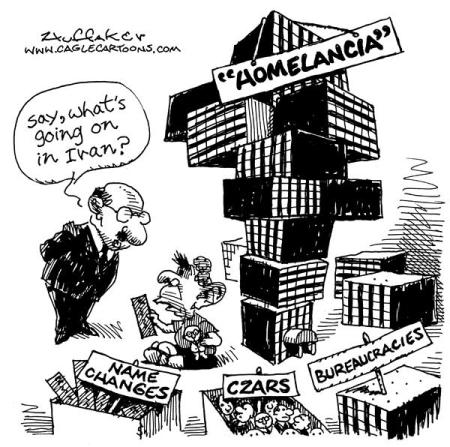
Bigger technology, larger police, more secret policemen. More prison ers, more killings b y the State. | Cartoon titled Intelligence Bureaucracies By Huffaker, Politicalcartoons.com – 5/8/2006 12:00:00 AM
Macro Numbers
US Census Bureau says, 63% of US population, is between the age of 18-65 – numbering 19.5 crores (from 31 crores). US DoJ data release for the year-2011, says the number of people in correctional system (probation, parole or prison) excluding under prosecution, is more than 70 lakhs – mostly from 18-65 years group. That is 70 lakhs people out of 19.5 crores – nearly 4% (3.63% to be exact).
Anyway you look at it, it is more than any other country in the world.
Each year, the US system has to deal with 2.1 crore people in prison, on probation or parole, or being prosecuted. Ranged against 2.1 crore law-breakers are 60 lakhs in the various types of police plus 10 lakhs in judiciary.
This totals to 2.8 crore people who are law-breakers or law enforcers from a working age population of 19.5 crores. With every seventh adult in the business of (il)legal-activity, makes US clearly a leader of the ‘Free’ World.

Bigger technology, larger police, more secret policemen. More prison ers, more killings b y the State. | Cartoon titled Intelligence Bureaucracies By Huffaker, Politicalcartoons.com – 5/8/2006 12:00:00 AM
Custodial Deaths
Perry Anderson then goes onto wite about the excesses of the Indian Police.
Arvind Verma writes that 53,000 people were arrested under the Terrorism and Disruptive Activities Act, of whom just 434 could be convicted seven years later, he underlines some daily realities of Indian democracy: ‘Torture is routinely practised in most police stations and death in police custody is a frequent phenomenon’
Before looking at Indian numbers, let us look at some American numbers.
In the words of the BoJ-Statistics department report, ‘At yearend 2007, federal and state prisons and local jails held just under 2.3 million inmates (2,293,157).’
The US Bureau of Justice reports a total of 32,834 custodial deaths in the USA for 2001-2007 period. This has been broken up into local prisons with 8,097 inmate deaths from a local prison population of 782,595. This data is for local prisons only – which are lower level prisons. State prisons accounted for 21,936 deaths and Federal prisons for 2801 during 2001-2007, totalling 24,737 custodial deaths in State and Federal prisons for the 2001-2007 period.
This does not include arrest-related deaths.
For India, a activista report gave out the statistics.
“Torture in India 2011” states that a total of 14,231 persons i.e. more than four persons per day died in police and judicial custody in India from 2001 to 2010. This includes 1,504 deaths in police custody and 12,727 deaths in judicial custody from 2001-2002 to 2009-2010 as per the cases submitted to the National Human Rights Commission (NHRC).
These deaths reflect only a fraction of the problem with torture and custodial deaths in India as not all the cases of deaths in police and prison custody are reported to the NHRC.
via 14,231 Persons Died In police And Judicial Custody In India From 2001 To 2010 By Suhas Chakma.
A comparison could be made by taking data on a pro-rata basis. Some 8,900 custodial death among 400,000 prisoners in India (2.23%) compared to nearly 33,000 deaths from a prisoner base of 2 million (1.65%).
This means 19 additional deaths each month in India. Does this speak of unspeakable torture and human abuse in a country of 120 crores, with a State policing apparatus that uses nearly 3 million ‘operatives’?
How many of these deaths could be due to pre-existing illnesses? India after all has the largest numbers of people affected by TB, diabetic, cardiac diseases. Prison conditions could easily result in higher mortality due to these illnesses. Poorer healthcare in Indian prisons?
Is this vastly different from mortality rates between general population in India and USA?
UPSA – United Police State of America
Overwhelming data point towards the fact the US is a police State beyond comparison. With
- 7 million people under some kind of correctional supervision – prison, parole or probation.
- With 2 million prisoners
- Some 3 million employees in US secret services (FBI, CIA, NSA, etc).
- 1 million civilian police as per FBI data
- More than 14 million prosecutions yearly (2002), to keep these 1 million police personnel busy. The US prosecutes more people than the next 45 countries for whom data is available.
It is fashionable in the US to moan over how powerful ‘secret police’ has become of late.
But this is not new.
For 48 years, Edgar Hoover headed FBI. No POTUS (President of the US), no GOTUS (Government of the US), no SCOTUS (Supreme Court of the US) could touch him. He had a file on everyone. Including musicians (like John Lennon) to many Hollywood starlets.
No State has taken so much offence against its own citizens as the GOTUS.
Of late, the US Government made more requests to Twitterto reveal confidential information, than all other Governments in the world put together.
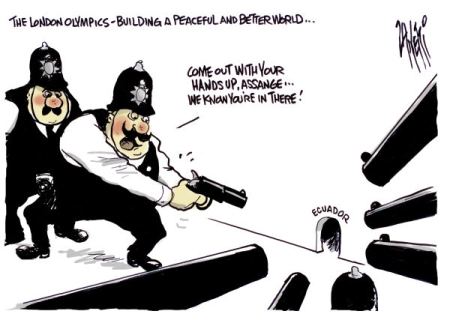
Was the persecution of Julian Assange useful, or essential for any other reason ? | Julian Assange Siege By Paul Zanetti, Australia – 8/16/2012 12:00:00 AM
Police Killing – In India & USPA
Coming to the point about Indian police killing civilians.
First, let us take data for people killed by US-police during line of duty.
Looking for the number of burglaries last year in Devils Lake, N.D.? How about the increase in property crimes in Caribou, Maine? The answers (34 and 23 percent, respectively) are readily available from the FBI.
Want detailed information on how many people were shot by police in the United States last year?
That’s not so easy to find.
The nation’s leading law enforcement agency collects vast amounts of information on crime nationwide, but missing from this clearinghouse are statistics on where, how often, and under what circumstances police use deadly force. In fact, no one anywhere comprehensively tracks the most significant act police can do in the line of duty: take a life.
“We don’t have a mandate to do that,” said William Carr, an FBI spokesman in Washington, D.C. “It would take a request from Congress for us to collect that data.”
Congress, it seems, hasn’t asked.
But let me confess. I am wondering is this is a case running and hiding …
A Pulitzer prize winning investigation by Washington Post, on Washington DC police practices concluded that the
extent and pattern of police shootings have been obscured from public view. Police officials investigate incidents in secret, producing reports that become public only when a judge intercedes. In a small hearing room closed to the public, nine of every 10 shootings are ruled justified by department officials who read the reports filed by investigating officers but generally hear no witnesses.
In the internal records used to track shooting trends, D.C. police undercounted by nearly one-third the number of people they killed from 1994 to 1997, tallying only 29 fatal police shootings. The Post investigation confirmed 43 fatal police shootings in that period. Seven fatal shootings were missing from police shooting trend records, and seven other fatal shootings were mislabeled as nonfatal.
The rise in police shootings in the mid-1990s went largely unnoticed among the top officials charged with policing the police.
“No one said there was a problem with shootings,” said Stephen D. Harlan, former vice chairman of the D.C. financial control board. Former D.C. chief Larry D. Soulsby, who presided over the department from 1995 to 1997, said the rise in shootings “was not a hot topic among police officials.”
Off-duty shootings have added to the total of District police shootings in the 1990s. When shooting incidents peaked in 1995, 36 percent of the shootings occurred while officers were off duty, considerably more than the 17 percent to 22 percent that various studies over the years have found in other large cities. Even more striking, more than half of the District’s 16 fatal shootings in 1995 happened off duty — compared with a national average that ranges from 9 percent to 16 percent, according to a study by the International Association of Chiefs of Police.
Many experts consider off-duty shootings problematic for several reasons: The officers are not readily identifiable; they may have been drinking; and they are usually acting alone without backup officers, making them more vulnerable and fearful.
The lawsuits that often follow off-duty police shootings have been costly to District taxpayers.
It appears that while FBI is not publishing or releasing this data, it is nevertheless available – as this 2008 report reveals.
The number of justifiable homicides committed by police and private citizens has been rising in the past two years to their highest levels in more than a decade, reflecting a shoot-first philosophy in dealing with crime, say law enforcement analysts.
The 391 killings by police that were ruled justifiable in 2007 were the most since 1994, FBI statistics show. The 254 killings by private individuals found to be self-defense were the most since 1997.
Police are justified, the FBI says, when felons are killed while the officer is acting in the line of duty. Rulings on these deaths are usually made by the local police agencies involved.
Some law enforcement analysts say the numbers represent changing attitudes on the streets, where police have felt more threatened by well-armed offenders.
via FBI: Justifiable homicides at highest in more than a decade – USATODAY.com.
What in the USA are called officer-involved shootings, in India are called police-encounters.
But there is marked difference in the way this has been handled.
Indian courts (including the Supreme Court), media, bureaucrats have been monitoring these cases – and passed strictures on some policemen and departments.
Killings of people from minorities (Muslims in India, like the US Blacks) arouses the systems’ ire. In the Sohrabuddin case, a high-ranking politician (Amit Shah) and a high-ranking police-official (DG Vanzara) are being prosecuted. The Batla House shooting continues to to be debated years after the incident. This is only of course, anecdotal evidence. Quantitative data is also given which dilutes Perry Anderson’s critique to nothing.
Meanwhile in the Washington, DC, USA
Three times in the last three years, police have shot fellow officers, killing two and wounding the third. In all three instances, white officers shot black officers in civilian clothes, including a pregnant female officer, after mistaking them for criminals.
India’s National Human Rights Commission (NHRC) has been meticulously compiling data and publishing this data. Media and civil activists have been involved in this. Given below is an extract from a report carried by an American magazine (Time) – which gives indicative data.
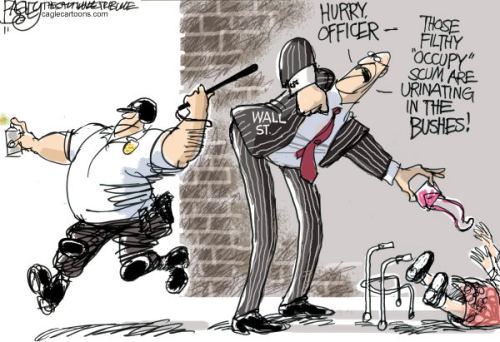
Mirror, mirror on the wall, who ia is worst of them all. | Lawless OWS Hippies By Pat Bagley, Salt Lake Tribune – 10/27/2011 12:00:00 AM
the violence is for real: public records show he has personally gunned down 87 gangsters in the mean streets of India’s film and organized crime capital since 1990. The 41-year-old’s scorecard has made him the country’s deadliest cop ahead of two other inspectors, Praful Bhosle, 46, and Vijay Salaskar, 45, who have clocked scores of 82 and 40, respectively. All three are from Bombay’s elite Criminal Intelligence Unit, which, as Mob crime spiraled out of control in the early 1990s, was tasked with taking down the bad guys, guns blazing if necessary. Few mobsters went quietly: police shot 71 in “encounters” in 1997, 83 in 1999 and 97 in 2001. In all, since records of shoot-outs began in 1982, police have killed 1,200 gangsters in and around Bombay.
The effect on India’s crime capital has been dramatic. From two a week at the height of the violence in the early 1990s, intergang gun battles are down to two a month. Once almighty syndicates are losing scores of men and millions of dollars because of the disruption to their businesses. Arun Gawli, who describes himself as a former Mafia don, sees himself as a virtual prisoner in his own mansion, living behind a phalanx of armed guards, CCTV and four separate locked gates, out of fear of what he calls “police contract killings.” “In a democracy, these sorts of killings are unlawful,” he says. Gawli, 51, claims he has lost a total of 60 associates to encounters in the past decade. “O.K., there were days a while back when I went astray. But this sort of murder campaign is way beyond acceptable.”
That’s a view shared by human-rights groups. Lawyer Seema Gulati even warns that the “growing trend of police killings” is endangering India’s democratic foundations. “They’re just bumping them off,” she says.
Police bosses counter that they are being criticized merely for being better shots than the Mafia. They add that none of the hundreds of complaints alleging staged shoot-outs or executions filed by victims’ relatives or human-rights groups or even a handful of official inquiries has ever led to a conviction for extrajudicial killing. “The allegations of fake encounters are baseless,” says Pradeep Sawant, Bombay’s deputy police commissioner. “It’s not that we always go to kill. Our idea is to arrest the gangsters. We only retaliate if we’re fired upon.”
Many in India argue that there are few alternatives, since the country’s judicial system is tainted by corruption and crippled by backlog. Kanwar Pal Singh Gill, India’s most famous cop for helping put down the Sikh insurgency in Punjab state in the 1990s, is blunt: “Our legal system doesn’t work at all. If there are no legal remedies, there’ll be extralegal ones.”
By and large, this is a compromise the public accepts. “We know the vast majority of encounters are fake,” says Hindustan Times editor Vir Sanghvi. “We do not think that this is a perfect situation, but in common with the rest of the middle class we have come to the regrettable conclusion that there is no real alternative.” For a professional enforcer like Sharma, success isn’t just measured in body bags or reduced gang violence, but invitations to celebrity parties and near unanimous media praise. “I don’t enjoy killing,” says Sharma. “But after we shoot some mobster, his victims look at me like God. That’s the best part of the job.”
via Urban Cowboys – TIME.
Based on official monitoring of such ‘encounters’ an updated Wikipedia entry gives more data.
According to the National Human Rights Commission of India, there were 440 cases of alleged fake encounters in the country during 2002-2007. Most of these happened in the states of Uttar Pradesh (231), Rajasthan (33), Maharashtra (31), Delhi (26), Andhra Pradesh (22) and Uttaranchal (19).[2]
From 2008-09 to June 2011, NHRC recorded 369 cases of alleged fake encounters. By June 2011, NHRC had resolved 98 of these cases, while the rest were pending settlement. The states with high number of cases were Uttar Pradesh (111), Manipur (60), West Bengal (23), Tamil Nadu (15) and Madhya Pradesh (15).[3]
via Encounter killings by police – Wikipedia, the free encyclopedia.
Though officially not published or collated, investigations by civil rights groups reveal indicative data about police officer-involved killings in the US.
The problem of fatal police shootings in America goes beyond a few bad apples. It points to persistent and systemic problems that lead to ongoing tragedies for communities of color. Between 1980 and 2005, close to 9,600 people were killed by police in America — an average of about one fatal shooting every day. However, the real number may be higher due to underreporting by some departments to the federal government. For example, the Los Angeles Police Department responded to a Freedom of Information Act request by claiming there were 79 fatal police shootings from 2000 to 2005. Yet only 38 fatal shootings were reported to the federal government for the same period.
While the precise number may not be clear, it is apparent that fatal shootings are not inevitable. Washington, D.C. had the nation’s highest rate during the 90s. It’s also clear that shootings are not distributed evenly throughout the population. In Chicago, for example, more than two-thirds of the shootings happened in black and Latino neighborhoods, and the majority of the incidents occurred in poor neighborhoods.
African Americans are particularly at risk of being killed by police. Black people were overrepresented among victims in each of America’s 10 largest cities. This contrast was particularly glaring in New York, Las Vegas and San Diego, where the percentage of black people killed was at least double their share of the general population. “There is a crisis of perception where African American males and females take their lives in their hands just walking out the door,” said Delores Jones-Brown, interim director of the Center on Race, Crime and Justice at John Jay College in New York. “There is a notion they will be perceived as armed and dangerous. It’s clear that it’s not a local problem.”
The shootings may be explained in part by implicit bias on the part of police officers, according to research by University of Chicago Professor Joshua Correll. In New York, connecting negative stereotypes with racial identity was considered as a factor in the 1999 fatal shooting of Amadou Diallo and the 2006 shooting of Sean Bell — both of which involved black male victims being killed by more than 40 shots fired by officers.
Another key part of the equation: a disturbing lack of internal accountability from local police departments.
In Chicago, nearly half of the officers sued in those shootings had been sued for previous violations. Most had been sued at least twice. Although being sued does not mean an officer is guilty, multiple lawsuits against the same officer should draw the department’s attention.
Yet little seems to happen to these and other officers accused of killing residents. Chicago’s initial “roundtable” investigations of 85 officers cleared all but one of them — and that officer got a promotion two years later. (Police officials said they did find fault among other officers but could not provide any statistics.)
A similar situation exists in Phoenix, which had the highest rate of fatal police shootings among the nation’s 10 largest cities. Although there were more than 100 incidents of officer-involved shootings in the city during the past five years, and numerous shootings in neighboring jurisdictions, only one shooting in the county has resulted in criminal charges being filed against the officer who fired — and that was for the fatal shooting of a white woman.
This broken system hurts everyone.
Multiple reports and studies seem to converge to an estimate of roughly 400 officer-involved fatalities in USA. The 2008-report extracted above also gives a similar figure. The latest Wikipedia listingof officer-involved fatalities for 2012, of the last 9 months is close to 400. Full year figures will cross 500 – unless there is intervention.
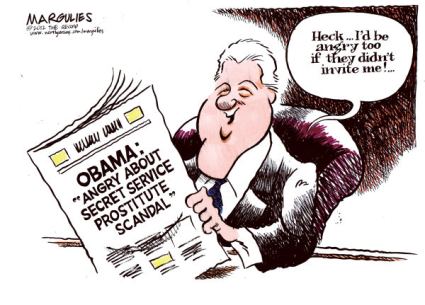
The US Secret Service Colombian prostitute scandal. Secret service agents on the POTUS detail ignored their job – and spent time on hiring prostitutes. | Cartoonist Jimmy Margulies in 2012
So, while in the USA, officer-involved deaths are around 400 per annum. In India the comparable figure is 75-80 ‘encounter’ deaths. Roughly in the same 4:1 to 5:1 prisoners ratio between US and India.
So the major difference in arrest-related deaths is the noise levels. While noise levels seem lower in US, in India these encounter deaths have evoked a significant backlash. Even mobsters like Arun Gawli thinks he can protest against these deaths.
Secret Police
With the biggest secret service in the world, the largest prisoner population, in addition to one of the the largest police forces in the world.
Regarding figures for people employed in pure intelligence work, India has some 25,000 people in the Intelligence Bureau. Compared to 30-lakh employees in US Secret Service. So, Perry-bhau, we are talking of 25,000 intelligence operatives in India – versus US that has 30 lakhs.
The predominant target of the US secret police are the 70 million American males in the 18-60 years of age. Thousands of organisations, controlled by 17 apex American secret service agencies track these 70 million people.
Industrial Security
If Perry Anderson would like to include the CISF, in India’s ‘vast military, paramilitary and surveillance complex’, then would he like to include its Western equivalent – like private security, which has the same function?
A report commissioned by the US-DoJ estimates that the private sector provides about 1 million employees for industrial security. Another million by provided to US defence and government establishments by Defense Industrial Security Clearance Office (DISCO) through contractors. That is a total of two million private security personnel.
Indian private security industry is estimated at Rs.25,000-30,000 crores by value – and about three million by head count.

The elite did manage to drive away the ‘usurpers’. | After the evacuation of OCCUPY WALL STREET By Patrick Chappatte, The International Herald Tribune – 11/21/2011 12:00:00 AM
Anecdotal Evidence
Remember Bradley Manning. Dare I remind you of the another marine Brandon Raub. Probably you don’t have the courage to advise your Government after Obama has signed the NDAA Bill. So, no bail, only jail, if Daddy does not like you.
You got problems at home. Save your ideas and lectures where it is needed most.
Nearly a 100 countries in the world have a population that is lesser than the number of US citizens in prison, on parole or probation, or under prosecution by the State.
Of course! It clicks now.
After all, Britain the mother-country of Anglo-Saxon Bloc, first annihilated the native populations and then populated the entire continent of Australia with such people.
‘A staggering number of laws that sanction the use of coercive powers have been enacted in India,’ Arvind Verma writes. Noting that 53,000 people were arrested under the Terrorism and Disruptive Activities Act, of whom just 434 could be convicted seven years later, he underlines some daily realities of Indian democracy: ‘Torture is routinely practised in most police stations and death in police custody is a frequent phenomenon,’ while – nominally outside the jails themselves – ‘the police practice of getting rid of suspects through staged encounters is unfortunately all too common. Suspects against whom the police are unable to bring substantial evidence or those who are perceived to be dangerous are simply murdered.’ Nor, while the police are at work, have the military been idle. In the 1960s, the army was deployed ‘in aid of the civil power’ some 476 times, and in 1979-80 alone, 64 times; often ‘openly stationed so as to provide a perpetual reminder, and on occasion an actual expression, of the fact that the existing social and political order in India is only to be challenged by its critics at their peril’.
Let us compare again.
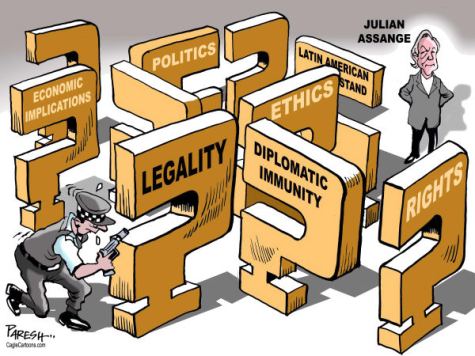
Big talk also means Big Walk. Questions on Assange By Paresh Nath, The Khaleej Times, UAE – 8/28/2012 12:00:00 AM
Behind Bars – Benchmark USA
Under all laws, all statutes, for all reasons, at all stages of prosecution, India has custodial population of 400,000 compared to the US with 2 million. N on -custodial prosecution figures are excluded from these figures.
Without getting technical or delicate, if we include all disappearances, encounter deaths as State Executions, the figure is less than the people executed in the US.
So …
Perry-bhau If our Indian Government wants to foolishly follow the Yumm-Rikan example, we will take care of it. Our Government! Our problem. Our solution. Don’t need no silly mindless, hectoring from you.
But I will limit it to one simple, suggestion. Give your gyaan to your YummRikan Government.
Related Articles
- After Nehru (3quarksdaily.com)
- Retrieving a History: Responding to Perry Anderson on India (3quarksdaily.com)
- The Kashmir Story: A Western Narrative (quicktake.wordpress.com)
- Disposable America (counterpunch.org)
- Ken Macleod on George Orwell, Perry Anderson, Politics, and the English Language (delong.typepad.com)
- The Big Lie About Police Brutality (counterpunch.org)
A Good Idea

Left, Right or Centre – why does Indian polity derive inspiration from the gutters of Western polity?
|
Ramachandra Guha correctly castigates, Indian Right and Left for adoring dubious Western (ized) leaders of the Right (Hitler, Mussolini) and Left (Stalin, Mao).
The Indian Marxists’s admiration of foreign dictators is a curious thing indeed. The Communist Party of India (Marxist) is the only party in the world which still worships Stalin, putting up his portrait alongside those of Marx, Engels and Lenin in their annual congresses. Yet the party has long ago abandoned armed struggle, and is happy enough to participate in the routine processes of Indian democracy.
Admittedly, hypocrisy of another kind is practised by parties of the Indian right. The founders of what is now the Bharatiya Janata Party were fervent admirers of Adolf Hitler and Benito Mussolini. And Bal Thackeray admires those fellows still.
via BIG BROTHER FASCINATION | BY RAMACHANDRA GUHA | Editorial – The Telegraph.
But, why does Ramachandra Guha ignore Centrist-India’s adoration of Anglo-Saxon polity in US and UK?
Why don’t we abhor Centrist monsters like Churchill who made Bengal into a huge gulag that ended with the death of some 4-5 million Indians, in the Great Bengal Famine. Churchill faulted Indians for the famine, because Indians ‘breed like rabbits?’ All this, while Indian grain was diverted for British soldiers.
Or why do we turn a blind eye to the modern American gulag, where each year, some 2 crore Americans (mostly Blacks) are prosecuted, imprisoned, are either on probation or parole. Supervised by 1 million civilian police, 3 million secret police, supervised by 2 million industrial police. This is more victims than the rest of the world combined. Or a bigger police force than the next 10 biggest police forces of the world combined.
Central to this discussion on the merits of Left, Right and Centre, is the fact that there is little difference in the outcome.
The Left, Right and Centre have similar outcomes – the same over-important role of the State; the identical concentration of wealth; the typical reliance on fear (imprisonment; execution) to control the citizenry.
The only system that offers an alternative is भारत्तंत्र Bharattantra.

Extract from: Modern South Asia: History, Culture and Political Economy – Sugata Bose – Google Books on 2012-09-23 15-33-44′ | Page 124. Click for source at books.google.co.in
When asked by a reporter, what he thought of the Western Civilization, Gandhiji replied ‘It would be a good idea.’
While Rajaji went galloping after American style capitalism, Nehru was besotted with European-socialism. It was left to Gandhiji alone to talk of panchayati raj and Ram rajya. Congress in free India was an idea that worried Gandhiji – and he called for a meeting to discuss this. But before this idea could be discussed at the proposed Wardha meeting, Gandhiji was assassinated.
Is this short Indian memory – or great Western propaganda?
Related Articles
- India’s Future: Not leaders! Not Institutions! Then How Will India’s Future Emerge? (2ndlook.wordpress.com)
- August 9: 70 years of Quit India Movement (ibnlive.in.com)
- Washington Post publishes correction in PM story (ibnlive.in.com)
- Karnataka’s links with the Mahatma (thehindu.com)
- Greatest Indian (thehindu.com)
- Critics round on India’s ‘complacent’ prime minister (guardian.co.uk)
Policing America: The Grip on the Population Tightens Visibly – Sometimes Even Invisibly

Each year US prosecutes more people than the rest of the world put together. US has more secret police, civilian police than any country in the world. Wassup?
|
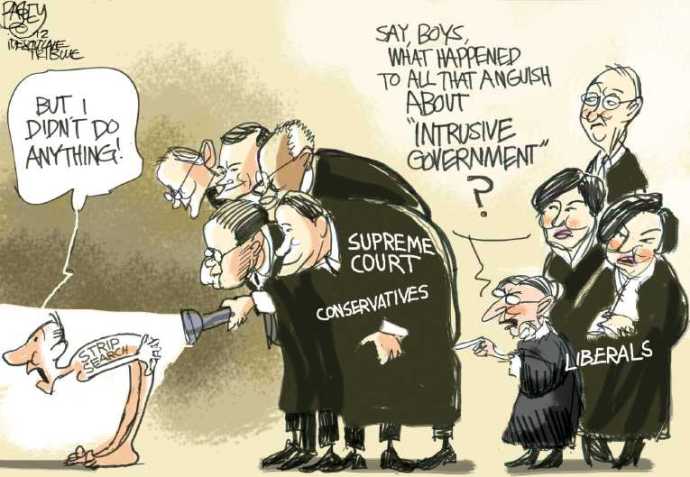
The SCOTUS has reaffirmed that the US police can stop anyone and do a personal body search based on a suspicion of a concealed weapon. | SCOTUS Up the Wazoo – Cartoon by Pat Bagley on Apr 3, 2012
Overwhelming data point towards the fact the US is a police State beyond comparison.
With
- 7 million people under some kind of correctional supervision – prison, parole or probation.
- With 2 million prisoners
- Some 3 million employees in US secret services (FBI, CIA, NSA, etc).
- 1 million civilian police as per FBI data
- More than 14 million prosecutions yearly (2002), to keep these 1 million police personnel busy. The US prosecutes more people than the next 45 countries for whom data is available.
In 2011, New York police stopped about 700,000 people on the road – and nearly half of these people were intrusively searched. One estimate put the total number of such searches in New York alone at 4 million – 40 lakhs, in the past decade.
All this in a city of eight million – a little larger than Pune. Imagine 2000 body searches every single day in Pune.

These personal body searches and CCTV surveillance has become common across the US | Cartoon titled Travel School and Prison By Andy Singer, on 11/20/2006
Police procedures demands that a the crotch is manually felt by hands – and in case of women, even the area between breasts.
Remember these figures are for New York only. National figures will be higher.
The New York City Police Department under its increasingly unpopular stop-and-frisk program (revealed) New Yorkers were stopped nearly 700,000 times last year.
Judge Shira Scheindlin of Federal District Court granted class action status to a lawsuit accusing the Police Department of using race as the basis for stopping and frisking New Yorkers. The judge rebuked the city for its “deeply troubling apathy toward New Yorkers’ most fundamental constitutional rights,” and found “overwhelming evidence” that the program had led to thousands of baseless, unlawful stops. Despite the police claims that the stops keep criminals and weapons off the streets, only about 6 percent of stops lead to arrests, and last year, only one in every 879 stops turned up a gun.
According to the department, it conducted 203,500 stops in January, February and March of this year — a record number — but stopped only 133,934 in April, May and June.
A young woman from Harlem Heights said police officers who claimed to be searching for a rapist interrupted her and two female friends, demanded identification and then patted her down. “It was uncalled-for,” she said. “It made no sense. How are you going to stop three females when you are supposedly looking for a male rapist?”
Not surprisingly 85% of these target were African-Americans and Hispanics.
Steve Kohut, born and raised in Manhattan’s Lower East Side, says he’s been stopped and frisked “more times than I can remember” since he was 12. “It was just life to me,” Kohut said.
He only realized that it was not common to all areas of the city when he visited a friend’s upscale neighborhood. It prompted him to question the practice. “Wait a minute, the cops don’t stop you every time you go to the store over here? They don’t do that to you? They don’t search you? They don’t push you up against a wall? They don’t put your face on the hood of their car?”
“It’s not a positive thing to just declare martial law on a colored community or a poor community, which is pretty much what they’re doing.”
In some areas, it has become reflex action for people to prepare themselves for a search – as soon as they see a policeman in uniform.
In her lower Manhattan office, Donna Lieberman, the executive director of the New York Civil Liberties Union, raises her hands in surrender.
Lieberman, 63, is miming the resigned reaction of young black and Latino men who she says are stopped and frisked so often by the New York Police Department that they put their hands in the air as soon as they see an officer approaching.
“The police don’t say a thing,” says Lieberman of the technique, which the NYPD says has netted 800 guns in a 10-year period. “They just go right for the pockets.”
via New York, Philadelphia police stops draw criticism – thestar.com.
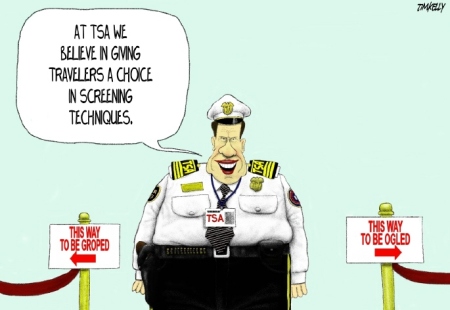
What’s on the menu? You got choice. A Police State or a Military State | by Tim Kelly at Monday, January 11, 2010
Is New York the only city where the police have gone berserk?
In Philadelphia, a court challenge to stop-and-frisk resulted in an agreement involving the mayor, the police commissioner and those who brought the suit, to make the force more accountable. Officers, who once recorded stop and frisk details on paper, now use mini laptops and that information goes into an electronic data base that can be monitored by Messing and the ACLU.In 2009, 250,000 people were stopped, principally black and Latino men, in a city of 1.5 million.
via New York, Philadelphia police stops draw criticism – thestar.com.
Unlike popular image, for years the legal, civil rights community and the media simply watched. The challenge to these abusive police searches mounted only after overwhelming evidence was built up.
In recent years, stop-and-frisk tactics employed by police departments in other major cities have been impugned by civil rights leaders. In 2010, the American Civil Liberties Union of Pennsylvania filed a class-action federal lawsuit against the Philadelphia Police Department. The lawsuit led to a settlement in which Philadelphia officials agreed to adopt safeguards to make sure police stops were conducted legally, and to accept oversight by an independent monitor. After the changes, the number of street stops declined.
via Number of New York Police Street Stops Falls 34 Percent – NYTimes.com.

TSA seems to be getting away with the most intrusive body search by any agency in the world | Future Travel by Cameron Cardow editorial; cartoonist for the Ottawa Citizen; Dec 14 2010.
These intrusive search procedures increased even as crime figures remained high.
the explosion in stop-and-frisks under Bloomberg’s administration – by 600% in the last decade – has had little impact on the number of people of shot in New York City, in contrast to claims made by the mayor and the commissioner that the practice is making the city safer. NYPD statistics reveal that 1,821 people were victims of gunfire in 2011, a figure which is almost identical to the 1,892 people who were shot in 2002 when Bloomberg came into office.
via NYPD’s stop-and-frisk policy to be reviewed by US department of justice | World news | guardian.co.uk.
Outrage followed and the complete lack of logic was revealed, as data of searches on the female-persons was revealed.
Last year, New York City police officers stopped 46,784 women, frisking nearly 16,000. Guns were found in 59 cases, according to an analysis of police statistics by The New York Times.
While the number of women stopped by officers in 2011 represented 6.9 percent of all police stops, the rate of guns found on both men and women was equally low, 0.12 percent and 0.13 percent, respectively. Civil rights leaders have argued that the low gun-recovery rates are a strong indication that the bulk of stop-and-frisk encounters are legally unjustified. (The number of police stops has dropped by more than 34 percent in recent months.)
When officers conduct stops upon shaky or baseless legal foundations, people of both sexes often say they felt violated. Yet stops of women by male officers can often involve an additional element of embarrassment and perhaps sexual intimidation, according to women who provided their accounts of being stopped by the police. And many incorrectly believe that the police, like Transportation Security Administration officers, are required to have female officers frisk women.
That search is not random; it is based on information provided to an officer, like a detailed description of an armed suspect, or actions that raise an officer’s reasonable suspicion that the woman may be armed, she added.
And although the police stops of women yielded very few guns, they did produce 3,993 arrests last year.
Crystal Pope, 22, said she and two female friends were frisked by male officers last year in Harlem Heights.
Besides, Ms. Pope said, she thought male officers were required to summon a female colleague when conducting a frisk.
That belief, though incorrect, is shared by many women, said Andrea Ritchie, a civil rights lawyer and co-coordinator of Streetwise and Safe, a nonprofit organization that focuses on police practices that affect young lesbian, gay, bisexual and transgender people who are also members of ethnic minorities.
via In Police Pat-Downs, Many Women See Sexual Overtones – NYTimes.com.
A brilliant PR coup to damp simmering public rage at these pat-downs, the TSA (in collusion, or otherwise) ensured media coverage of a pat-down done on Henry Kissinger.
TSA screeners at New York’s LaGuardia Airport gave former Secretary of State Henry Kissinger a pat-down. The 88-year-old Nobel Peace Prize winner was in a wheel chair because of the long walk to the gate when he was pulled aside for screening.
Witnesses were shocked at the sight of him being patted down, and said it looked like the agents had no idea who Kissinger was.
via Former Secretary of State Henry Kissinger Given Pat-Down by TSA | Fox News Insider.
In recent months, several officers said, many sergeants conducting roll calls have stopped emphasizing the need to stop and question people on the street.
“They don’t ask for it anymore,” an officer in the Bronx said. “They just stopped.”
This is key, the officer said, because when sergeants were asking for them, “it starts becoming a quota or a production goal.”
“Why is it so important how many 250s someone did?” the officer added, referring to a form, a UF-250, filled out after a stop-and-frisk episode.
After the first quarter of 2012, police and city officials began to wonder how high the number would go in future years, and some privately questioned why the number of street stops continued to rise even as crime levels remained relatively flat in recent years.
via Number of New York Police Street Stops Falls 34 Percent – NYTimes.com.
In police parlance, this is called a Terry search. The SCOTUS decided in this case that as long as a policemen believed that a person
- Had committed
- Was going to commit a crime
- Probably armed
the police had a right to search.
One more minute, and it becomes clear that anyone can be searched under these three qualifications.
The constitutional origin and basis for police protective searches stems from the U.S. Supreme Court case of Terry v. Ohio (392 U.S. 1 (1968). In the Terry case, the high court first considered the issue of whether police pat downs were constitutional. That case evaluated the police practice of weapon searches on accosted persons and deemed it governed by the U.S. Constitution’s Fourth Amendment protections.
The decision stood for the proposition that police protective searches were legitimate and constitutional, as it established justifications for the searches in the jurisprudence. Specifically, the supreme court held in Terry that the Fourth Amendment’s bar on unreasonable searches and seizures is not violated by the police when they stop a suspect and pat down that suspect without probable cause to arrest him or her, so long as the police have a reasonable suspicion that the suspect committed, is committing, or committed an offense, and the officer has a reasonable belief that the suspect might be dangerously armed.
via What Is Permissible During a Police Pat Down? – Attorneys.com.
With one law-breaker or law enforcer, for every 17 adult males, the US is a world leader. For the 70 million American males in the 18-60 years of age who are the predominant target; there are 17 apex American secret service agencies that track these 70 million people. The biggest secret service in the world, the largest prisoner population, in addition to one of the the largest police forces in the world, make US clearly a leader of the ‘Free’ World.
those opposed to the Transportation Security Administration’s (TSA) new ‘enhanced’ pat down searches is that these pat downs violate a traveler’s Fourth Amendment rights.the Fourth Amendment to the United States Constitution it reads “The right of the people to be secure in their persons, houses, papers, and effects, against unreasonable searches and seizures, shall not be violated, and no Warrants shall issue, but upon probable cause, supported by Oath or affirmation, and particularly describing the place to be searched, and the persons or things to be seized.”While the new TSA enhanced pat downs may violate the Fourth Amendment on the surface,
the 9th Circuit Court of the United States ruled on the search of passengers in airports back in 1973, which effectively suspends limited aspects of the Fourth Amendment while undergoing airport security screening.
In 1973 the 9th Circuit Court rules on U.S. vs Davis, 482 F.2d 893, 908, there are key pieces of wording that give the TSA its power to search essentially any way they choose to. The key wording in this ruling includes “noting that airport screenings are considered to be administrative searches because they are conducted as part of a general regulatory scheme, where the essential administrative purpose is to prevent the carrying of weapons or explosives aboard aircraft.”
U.S. vs Davis goes onto to state “[an administrative search is allowed if] no more intrusive or intensive than necessary, in light of current technology, to detect weapons or explosives, confined in good faith to that purpose, and passengers may avoid the search by electing not to fly.”
U.S. vs Davis was upheld by the 9th Circuit Court in 1986 in U.S. vs Pulido-Baquerizo, 800 F.2d 899, 901 with this ruling “To judge reasonableness, it is necessary to balance the right to be free of intrusion with society’s interest in safe air travel.”
These 9th Circuit Court ruling laid the path for the creation of Public Law 107-71, the Aviation Transportation and Security Act, which was virtually unopposed by legislators when it was it was signed into law on the 19th of November 2001 by President George W. Bush. This law laid the groundwork for the Transportation Security Administration and the evolution of its current security procedures.
These laws give the Department of Homeland Security (DHS) and Transportation Security Administration significant legal latitude to perform the searches utilizing their current procedures without fear of violating the Fourth Amendment.
via How The TSA Legally Circumvents The Fourth Amendment – Flying With Fish.
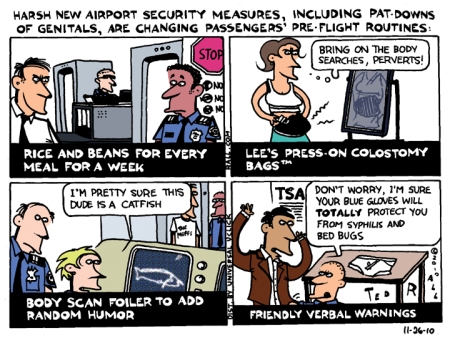
Simmering discontent about the intrusion is now out on the streets too | Pre-Flight Check. Friday, November 26th, 2010 by Ted Rall. at cartoonistswithattitude.org
The Terry pat-down industry in the US Police got a big boost when the Supreme Court of the United States (SCOTUS) upheld the police case against Lemon Montrea Johnson (argued December 9, 2008–Decided January 26, 2009) that police did indeed have the power to stop and search for weapons – and any other item which discovered during this search could be grounds for prosecution.
The U.S. Supreme Court decided today that, based on an Arizona case, cops who pull vehicles over in traffic stops can pat down passengers for weapons without any suspicion of wrongdoing.
We suspect this ruling could make it easier for unscrupulous police officers to abuse typical search standards.
Anytime an officer is suspicious someone is carrying drugs or other illegal contraband, the person can be searched for “weapons.” The officer has nothing to lose, now that the Supreme Court has spoken: If the search produces no weapons, there’s no legal foul ball. But if it produces drugs, the cop is rewarded with a felony bust.
via Pat-Downs of Passengers by Police Approved by U.S. Supreme Court – Phoenix News – Valley Fever.
A few cases have been overturned – but these precedents have not been enough, in number or strength of juridical importance, to turn the tide.
The Court of Appeals recently reaffirmed the long standing rule that an officer who conducts a traffic stop must have a particularized suspicion that an occupant of the vehicle poses a safety threat before the occupant can be patted-down. The Court went on to hold that this rule holds true even if the officer intends to search the vehicle.
In Molina v. State, a Gwinnett County case, an officer conducted a traffic stop of a pickup truck after noticing a broken tail light. Upon being asked by the officer, the driver consented to a search of the truck. The driver and the passenger, Molina, were then asked to step out of the truck. A backup officer conducted a “Terry pat-down” of Molina to search for weapons. During the pat-down, the officer felt “a large brick-like substance or material or object in his front waistband.” Unsure as to whether the brick was a weapon or drugs, the officer pulled the brick out and discovered that it was a kilo of cocaine. Molina was then charged for trafficking in cocaine.
At the suppression hearing, the officer testified on direct that prior to the pat-down Molina was breathing heavily and that the artery in his neck was pounding rapidly. The officer also stated: “Other than that. . . [he] was pretty normal.” On cross, the officer stated that he patted-down Molina immediately after he exited the truck. The officer also stated, “Every time we have a consent to search and we get someone out of a vehicle, I always pat them down for weapons.” The officer explained: “While I’m going to be tucked inside somebody’s car I want to know if while they’re standing out there they’re armed.” Molina lost the suppression hearing, and following a bench trial, he was sentenced to the minimum 25 years in prison and a $1 million fine.
On appeal, the Court of Appeals reasoned that, “If the officer has a particularized basis for his suspicion the defendant might be armed or dangerous, he may frisk a suspect.” Quoting Terry v. Ohio, the Court went on to state that, “the issue is whether a reasonably prudent man in the circumstances would be warranted in the belief that his safety or that of others was in danger.”
The state Supreme Court has thrown out the 2005 methamphetamine conviction of an Olympia man, ruling that police had no right to frisk him just because he was apparently intoxicated and acting nervous in a public building.
The unanimous court overturned a decision by a Thurston County judge and the state Court of Appeals, both of which had found Lt. Don Stevens of the Tumwater Police Department justified in patting down Michael Setterstrom for weapons.
Bystanders had called police the morning of Feb. 28, 2005, to complain that Setterstrom appeared intoxicated.
The court’s ruling means that evidence seized because of that search — including a baggie of methamphetamines — is inadmissible. Setterstrom, who served six months in jail for the conviction, will have the conviction reversed.
According to the court opinion, Setterstrom lied to Stevens about his name, was fidgety and seemed nervous.
Even though Setters actually do or say anything threatening, Stevens frisked him. While he felt hard objects in the man’s front pocket, he testified “that none felt like a gun.”
Among the items the officer pulled from the pocket was a small baggie containing white powder. Stevens placed it all on the bench and told Setterstrom he was under arrest.
“What happened next was, we assume, unusual,” wrote Justice James R. Johnson for the court. “Setterstrom dropped to his knees, grabbed the baggie, and swallowed it.”
Efforts to make Setterstrom spit it out were not successful, and Johnson wryly noted that, “For obvious reasons, police never recovered the baggie.”
Based on these actions, Setterstrom was arrested and Stevens obtained a search warrant for his backpack, where officers found a small safe containing a baggie of methamphetamine, a syringe, a pipe and a set of scales. In Thursday’s ruling, the justices said that because the original pat-down was illegal, so was the search warrant that resulted from it.
while officers have every right to protect themselves, they must have a reason to suspect someone may be armed and dangerous.
“Officers must have some basis beyond nervousness and lying to justify the intrusion of a frisk,” the opinion said. “The officer here lacked such a basis.”
via Local News | Court: Police pat-down was not justified | Seattle Times Newspaper.
In JOHNSON v. THE STATE, (A11A0941.), Judge McFadden, dissenting wrote
Officer Spahr lacked authority to conduct the pat-down; and Johnson’s consent to the subsequent search that turned up the drugs was not freely and voluntarily given, but rather was tainted by the illegal pat-down. Therefore, the trial court should have granted Johnson’s motion to suppress, and I would reverse his conviction.I now turn to the question whether Officer Spahr had constitutionally adequate grounds to conduct the pat-down search. I would find that the state did not meet its burden of establishing that Spahr reasonably suspected that Johnson was armed and dangerous or otherwise a threat to his personal safety. So Spahr did not have constitutionally adequate grounds for the pat-down.Before an officer places a hand on the person of a citizen in search of anything, he must have constitutionally adequate, reasonable grounds for doing so. If an officer conducts a pat-down for weapons without sufficient justification, any evidence discovered is inadmissible under the exclusionary rule. Constitutionally adequate, reasonable grounds for a pat-down for weapons for officer or bystander safety are present when, based on particular and articulable facts, the officer actually and reasonably suspects that the individual is armed and dangerous or is otherwise a threat to personal safety.The state has the burden of proving that the pat-down was lawful. Molina, 304 Ga.App. at 95. That burden entails proving that the officer reasonably believed the suspect to have been “armed or otherwise dangerous.” No right is held more sacred, or is more carefully guarded, by the common law, than the right of every individual to the possession and control of his own person, free from all restraint or interference of others, unless by clear and unquestionable authority of law.Since the pat-down was illegal, the relevant question becomes whether Johnson’s consent to the subsequent search that turned up the drugs was voluntarily given and not the product of the illegal pat-down. Johnson argues that he did not freely and voluntarily give his consent because he was surrounded by three officers, one of whom had already conducted the illegal pat-down, and he was not told that he could leave. In other words, Johnson contends that the encounter had not de-escalated into a first-tier encounter, and therefore his consent was not voluntary. To determine whether the encounter became consensual, the courts must look to the totality of the circumstances in determining whether a reasonable person would have felt free to leave.
via JOHNSON v. THE STATE, A11A0941., December 01, 2011 – GA Court of Appeals | FindLaw.
Anything left out …
There are some other developing ‘stories’, which are equally a cause for worry spread over the USA.
County officials are looking into an almost 70% spike in fatal officer-involved shootings in Los Angeles County last year but said it’s too early to tell what, if anything, drove the jump.
Fifty-four people were fatally shot by authorities in 2011, according to autopsy reports analyzed by The Times, an increase all the more notable because it occurred at a time when the number of homicides in the area fell to historic lows. With 612 people killed in the county last year, nearly 1 in every 10 such deaths occurred at the hands of law enforcement officers.
via L.A. County officials looking into spike in fatal police shootings – latimes.com.
In US capital, Washington, DC, an anti-prostitution law is being watched with interest by the rest of USA.
In areas designated as prostitution-free zones, police can make arrests for up to 24 consecutive days if two or more people congregate in public in certain neighborhoods and ignore dispersal orders.
In his testimony, Newsham told council members that the city’s well-publicized prostitution-free zones appear to have played only a minor role in an overall reduction of prostitution in the city. Despite common perceptions, Newsham said, police have never made an arrest using the prostitution-free zone statute.
“While PFZs may have contributed to a temporary displacement of street-level prostitution, development and changing trends in prostitution have likely played a greater role,” Newsham said, noting that there has been a steep decline in prostitution-related calls in the District.
Courts upheld a person’s right to loiter so long as it’s not “being done with the specific intent to commit an illegal act.” Under current law, Gorman said, police do not need “probable cause” to arrest someone using the prostitution-free zone statue.
“It’s about disrupting,” Mendelson said. “If the market has to move because of a prostitution-free zone, it’s going to hurt business.”
So how do police identify prostitutes?
Over 1,200 people have signed a petition to demand the right to carry three condoms in the District of Columbia without fear of arrest. Why do 1,200 people think that carrying more than two condoms is against the law?
Widespread media reports of a “three-condom rule” in D.C. began with an item on RH Reality Check investigating the District’s anti-prostitution provisions. The item, written by researchers Aziza Ahmed and Brook Kelly, claimed that in the District of Columbia, “Anecdotal evidence suggests that having three or more condoms is considered a proxy for being a sex worker.”
Last week, the three-condom rule hit Jezebel, where it received 4,426 page-views—and inspired dozens of comments from women concerned that a late-night prophylactic run could send them behind bars. “Don’t many brands sell in 3-packs? Anyone who carries around a new package is automatically carrying 3,” one wrote. “so people in long term relationships that decide to stock up are really screwed,” wrote another. Feministing also picked up the three-condom rule. On Amplify, Jaclyn Friedman worried that her new “cute red vinyl condom case” designed to hold three Trojans could be grounds for arrest. “I once used over a dozen [condoms] in a particularly memorable weekend,” Friedman writes. “And I still wasn’t a sex worker.” Meanwhile, Dibranco’s post has been viewed over 40,000 times.
Where did this “three-condom rule” originate?
It’s not a legal standard. In D.C., police can set up temporary “Prostitution Free Zones” where officers who suspect you of loitering with the intent to commit prostitution can force you to leave the area. If you don’t leave, they can arrest you. The zone can remain in place for up to 10 days. According to the Prostitution Free Zone Law, “prostitution-related offenses” include “repeatedly beckoning to, stopping, attempting to stop, or attempting to engage passers-by in conversation for the purpose of prostitution,” “stopping or attempting to stop motor vehicles for the purpose of prostitution,” or “repeatedly interfering with the free passage of other persons for the purpose of prostitution.” Cops can also ask you to disperse if they recognize you from previous incidents as a gang member or a sex worker, or if a “reliable source” informs the police that they have observed you engaging in prostitution. The law contains plenty of objectionable procedures—they can make me leave my neighborhood if someone “reliable” tells them I’m a sex worker?—but no mention of contraceptives.
According to D.C. police spokesperson Gwendolyn Crump, carrying condoms can lead an officer to suspect prostitution—but there’s no three-condom arrest rule. “Although the possession of multiple condoms may be a factor that leads an officer to suspect (reasonable suspicion) that a person is engaged in prostitution, it is not enough to establish probable cause for any crime,” Crump writes. “Depending on the circumstances, factors such as this may justify an investigative stop—but not an arrest.”
Of course, it’s possible that some D.C. police officers don’t always follow the letter of the law. Is there any evidence that D.C. police have an internal three-condom rule?
According to the report, 8.6 percent of sex workers interviewed claimed that officers had taken “safe sex supplies” from them during their interactions with police; the report also cites evidence of police officers seizing or destroying condoms in Las Vegas and San Francisco. Again, the report’s findings reveal police conduct that can be extraordinarily harmful for D.C.’s sex workers. However, the report includes no magic number of condoms required to ignite suspicion—and it doesn’t provide any evidence that condoms alone are enough to get you locked up.
via Can Having Three Condoms In D.C. Really Get You Arrested? – The Sexist.
For a short while it did appear that the this Prostitution-Free Zone practice was effective. There seemed to be a reduction in prostitution.
The prostitution landscape in the nation’s capital is changing.
WAMU-FM’s “Metro Connection” reported on the District of Columbia’s crackdown on prostitution and why it is that prostitution is moving from areas downtown into residential neighborhoods, especially in Ward 7 east of the Anacostia River.
The migration mostly has to do with a 2006 law that allows chief of the Metropolitan Police Department to temporarily designate some areas of the city as “prostitution-free zones.” In such areas, it is “unlawful for a group of two or more persons to congregate in a public space or property in that area for the purpose of engaging in prostitution or prostitution-related offenses.”
Contrary to public opinion, the carrying of more than two condoms is not itself enough to get a person arrested for prostitution though the City Paper’s former sex columnist Amanda Hess did find that carrying multiple condoms in a prostitution-free zone can lead an officer to suspect that a person is a sex worker — which, in a prostitute-free zone, is enough for the police to tell the person to disperse.
Most of the PFZs so far have been downtown, which has pushed prostitution into other parts of the nation’s capital. WAMU reports that in Ward 2, the downtown jurisdiction traditionally known as D.C.’s prostitution hub, arrests have gone down by 10 percent in the past 10 years. But east of the Anacostia River, arrests have tripled in Ward 7.
The group told WAMU it isn’t seeing any overall decrease in the number of prostitutes working in D.C., though — it’s the same number of prostitutes, just working in different places– More dangerous places, say sex worker advocates.
Related Articles
- San Francisco mayor drops ‘Stop and frisk’ (rt.com)
- In Poll, Majority of New Yorkers Say Police Favor White People (nytimes.com)
- Street Stops in New York Fall as Unease Over Tactic Grows (nytimes.com)
- HW Qoute of the Week: “Stop-and-Frisks Has Dropped…More Than 34 Percent” (harlemworldmag.com)
Why Do We Love Our Invaders So Much?

Colonial history produces in the minds of many English-speaking Indians, the belief that India has been a rather frequent military loser – even though facts are otherwise.
|
Colonial history, left largely untouched after Indian Independence, produces it own kinds of stunted minds. A 2ndlook reader responded with a revealing comment.
being a Hindu from east India (Bengal – Assam), believe me I would Any Day prefer the british or east India company, rather than live under nawab’s, muslim league, tikka khans (u know who was tikka khan, maybe you don’t know about the pakistan genocide of east bengali hindus in 70-71).
Ever head of the begali hindu renassiance in the 18-19 centuries (or for that matter the general Hindu reniasance all over india). I am sure u’ll be upset / angry / bitter to learn that it started once the british has booted out the nawbs / mughals
Koenraad Elst, recently wrote a blog-post calling Hindus cowards, questioning if they are all right in all the departments. All this because Hindus were not hounding out Muslims from India – or at least making them second-class citizens, if not putting them in concentration camps.
To make this point, Elst picked up on India’s partition (1947) into India and Pakistan (to later subdivide into Pakistan and Bangla Desh.).
Anglophiles apart, it is an accepted reading of events for the 1940-1947 period when the Partition was formalized, that the British did encourage Jinnah to make strident, aggressive claims for disproportionate authority and veto powers in the soon-to-be independent India – failing which, India must be partitioned.
Some 2ndlookers felt that Elst’s absolution given to the British, for the Partition of India was a trial balloon by vested interests. A logical doubt, as Koenraad Elst’s writing has been suspect – and his ‘scholarship’ distasteful.
It is Elst’s proposition in his post (linked above) – unsupported by any facts, links, citations, references that the British wanted a united India – but it was Muslims led by Jinnah who wanted otherwise.
Curiously, the most significant support for Elst came from some Indians. Some interesting ramifications and reactions to this debate.


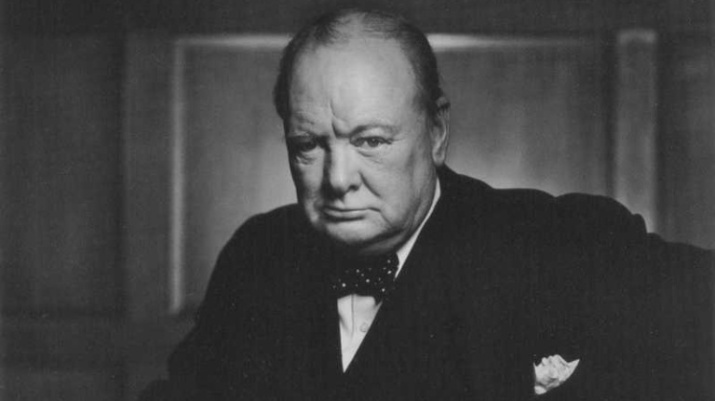
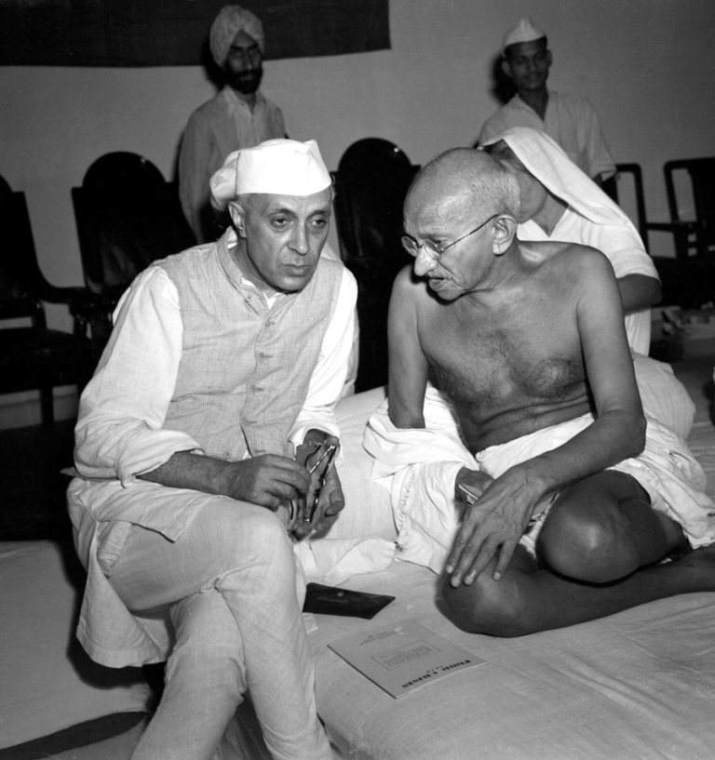














18 comments